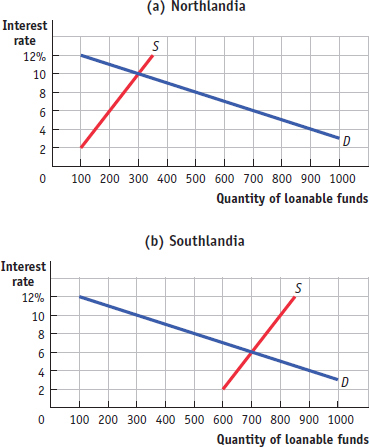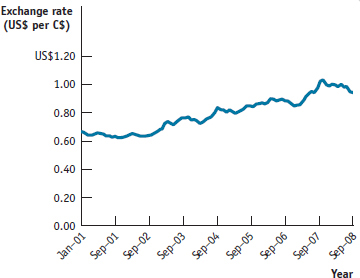19.7 PROBLEMS
How would each of the following transactions be categorized in Canada’s balance of payments accounts? Would it be entered in the current account (as a payment to, or from, a foreigner) or the financial account (as a sale of assets to, or purchase of assets from, a foreigner)? How will the balance of payments on the current and financial accounts change?
A French importer buys a case of Ontario ice wine for $500.
A Canadian who works for a French company deposits her paycheque, drawn on a Paris bank, into her bank in Regina.
A Canadian buys a bond from a Japanese company for $10 000.
A Canadian charity sends $100 000 to Africa to help local residents buy food after a harvest shortfall.
The accompanying diagram shows Canadian-
owned assets abroad and foreign- owned assets in Canada, both as a percentage of Canada’s GDP. As you can see from the diagram, both have trended upward from 1981 to 2011, especially Canadian- owned assets abroad. 
Since Canadian-
owned assets abroad increased as a percentage of GDP, does this mean that Canada, over the period, experienced net capital outflows? Compare the net capital flows in in the early 1980s to the net capital flows in the late 2000s. Did the net capital flows increase or decrease? Why?
In the economy of Scottopia in 2012, exports equalled $400 billion of goods and $300 billion of services, imports equalled $500 billion of goods and $350 billion of services, and the rest of the world purchased $250 billion of Scottopia’s assets. What was the merchandise trade balance for Scottopia? What was the balance of payments on current account in Scottopia? What was the balance of payments on financial account? What was the value of Scottopia’s purchases of assets from the rest of the world?
In the economy of Popania in 2012, total Popanian purchases of assets in the rest of the world equalled $300 billion, purchases of Popanian assets by the rest of the world equalled $400 billion, and Popania exported goods and services equal to $350 billion. What was Popania’s balance of payments on financial account in 2010? What was its balance of payments on current account? What was the value of its imports?
Suppose that Northlandia and Southlandia are the only two trading countries in the world, that each nation runs a balance of payments on both current and financial accounts equal to zero, and that each nation sees the other’s assets as identical to its own. Using the accompanying diagrams, explain how the demand and supply of loanable funds, the interest rate, and the balance of payments on current and financial accounts will change in each country if international capital flows are possible.

Based on the exchange rates for the first trading days of 2012 and 2013, as shown in the accompanying table, did the Canadian dollar appreciate or depreciate during 2012? Did the movement in the value of the Canadian dollar make Canadian goods and services more or less attractive to foreigners?
 Source: Pacific Exchange Rate Service (UBC).
Source: Pacific Exchange Rate Service (UBC).
Go to fx.sauder.ubc.ca. Use the table “The Most Recent Cross-
Rates of Major Currencies” to determine whether the British pound (GBP), the U.S. dollar (USD), the Japanese yen (JPY), the euro (EUR), and the Swiss franc (CHF) have appreciated or depreciated against the Canadian dollar (CAD) since January 2, 2013. The exchange rates on January 2, 2013, are listed in the table accompanying Problem 6 above.
Suppose Canada and the United States are the only two trading countries in the world. What will happen to the value of the Canadian dollar if each of the following events occurs, other things equal?
The United States relaxes some of its import restrictions.
Canada imposes import tariffs on American goods.
Interest rates in Canada rise dramatically.
A report indicates that Canadian wheat is of better quality than American wheat. In particular, consumers of Canadian grown wheat will enjoy much better health.
From January 2001 to June 2003, the U.S. federal funds rate decreased from 6.5% to 1%. During the same period, the target for the overnight rate at the Bank of Canada decreased from 4.75% to 3.25%.
Considering the change in interest rates over the period and using the loanable funds model, would you have expected funds to flow from Canada to the United States or from the United States to Canada over this period?
The accompanying diagram shows the exchange rate between the U.S. dollar and the Canadian dollar from January 1, 2001, through September 2008. Is the movement of the exchange rate over the period January 2001 to June 2003 consistent with the movement in funds predicted in part (a)?
 Source: Statistics Canada.
Source: Statistics Canada.
In each of the following scenarios, suppose that the two nations mentioned are the only trading nations in the world. Given inflation and the change in the nominal exchange rate, which nation’s goods become more attractive?
Inflation is 10% in Canada and 5% in Japan; the Canadian dollar–
Japanese yen exchange rate remains the same. Inflation is 3% in Canada and 8% in Mexico; the price of the Canadian dollar falls from 12.50 to 10.25 Mexican pesos.
Inflation is 5% in Canada and 3% in the eurozone; the price of the euro falls from C$1.30 to C$1.20.
Inflation is 8% in the United States and 4% in Canada; the price of the Canadian dollar rises from US$0.60 to US$0.75.
Starting from a position of equilibrium in the foreign exchange market under a fixed exchange rate regime, how must a government react to an increase in the demand for the nation’s goods and services by the rest of the world to keep the exchange rate at its fixed value?
Suppose that Albernia’s central bank has fixed the value of its currency, the bern, to the Canadian dollar (at a rate of C$1.50 to 1 bern) and is committed to that exchange rate. Initially, the foreign exchange market for the bern is also in equilibrium, as shown in the accompanying diagram. However, both Albernians and Canadians begin to believe that there are big risks in holding Albernian assets; as a result, they become unwilling to hold Albernian assets unless they receive a higher rate of return on them than they do on Canadian assets. How would this affect the diagram? If the Albernian central bank tries to keep the exchange rate fixed using monetary policy, how will this affect the Albernian economy?

Your study partner asks you, “If central banks lose the ability to use discretionary monetary policy under fixed exchange rates, why would nations agree to a fixed exchange rate system?” How do you respond?